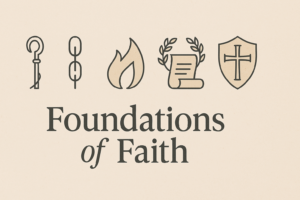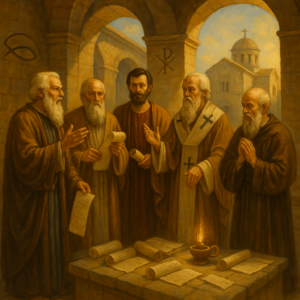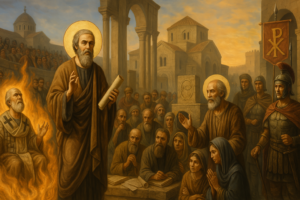Estimated reading time: 15 minutes
Key Takeaways
The early church fathers laid the foundational doctrines of Christianity that we embrace today.
- Apostolic Fathers like Clement, Ignatius, and Polycarp directly connected us to the teachings of the apostles.
- Irenaeus taught us to stand firm in truth against false teachings.
- Justin Martyr exemplified how faith and reason can work together to defend Christianity.
- Understanding the Nicene Creed helps us grasp the core beliefs that unify Christians worldwide.
Early Church Fathers: Foundations of Christian Faith
The early church fathers were the influential leaders and theologians who shaped Christianity in its formative years. These remarkable men lived between the 1st and 8th centuries AD and provided the crucial link between Jesus’s apostles and later generations of believers.
Think of these spiritual giants as the architects who took the blueprint of faith from Jesus and the apostles and constructed the foundation of Christian doctrine we know today. Their writings, teachings, and sometimes even martyrdom gave us the theological framework that billions of Christians follow.
Why should modern Christians care about these ancient voices? Because understanding the early church fathers helps us grasp the roots of our faith. Their struggles with heresy, persecution, and doctrinal debates created the spiritual heritage we often take for granted.
As we journey through their wisdom, you’ll discover seven transformative lessons that can deepen and revitalize your faith today.
Apostolic Church Fathers: Bridging the Apostolic Age
The earliest church fathers, called the Apostolic Fathers, lived between approximately AD 100-150. What makes them special is their direct connection to Jesus’s apostles. Many were actual disciples of the original apostles!
These apostolic church fathers include:
- Clement of Rome (died around AD 99)
- Ignatius of Antioch (died around AD 110)
- Polycarp of Smyrna (died around AD 155)
These men formed a human bridge connecting the apostolic age to early Christianity. They preserved apostolic teaching when the church was young and vulnerable to false teachings.
The formation of Christian doctrine didn’t happen instantly. It was a gradual process where these early leaders carefully examined Scripture, apostolic teachings, and the rule of faith passed down from the apostles. They met in councils, wrote letters to churches, and sometimes debated fiercely to ensure orthodox teaching prevailed.
Their work was crucial because they operated in a world where Christianity faced both external persecution from Roman authorities and internal threats from heretical movements. Their courage and clarity helped establish what Christians should believe about essential matters like:
- The nature of Christ
- The meaning of salvation
- How the church should function
- Which writings should be considered Scripture
By understanding these early foundations, we gain a deeper appreciation for the doctrines many Christians now accept without knowing their origins.
Irenaeus Against Heresies: Standing Firm for Truth
Irenaeus of Lyons (c. 130-202 AD) stands as one of Christianity’s most important early defenders. As bishop of Lugdunum in Gaul (modern Lyon, France), he fought tirelessly against false teachings threatening the young church.
His most significant contribution was his masterwork “Against Heresies,” where he systematically dismantled Gnosticism—a dangerous belief system claiming special secret knowledge was needed for salvation. Irenaeus countered by emphasizing:
- The unity of God as Creator of all things
- The reality of Christ’s physical incarnation and resurrection
- The importance of apostolic succession and tradition
- The authority of the four Gospels we know today
Lesson 1: Stand firmly for truth when popular ideas contradict core Christian teachings.
Irenaeus teaches us to defend truth lovingly but firmly. In our age of relativism and “personal truth,” his commitment to objective doctrinal boundaries reminds us that not all spiritual ideas are equally valid.
His approach to refuting false teaching was thorough but respectful. He took time to understand opposing viewpoints before carefully showing why they contradicted apostolic teaching. This model of thoughtful engagement with cultural ideas remains valuable for believers today.
St Justin Martyr: Faith Meeting Philosophy
Justin Martyr (c. 100-165 AD) exemplifies how Christianity engaged with the intellectual currents of its day. Born into a pagan family, Justin studied various philosophical systems before finding Christianity—which he called “the only safe and profitable philosophy.”
What made Justin special was his ability to:
- Explain Christian concepts using Greek philosophical language
- Show how Christianity fulfilled what was best in pagan thought
- Defend Christian practices against misunderstandings
- Argue for the moral superiority of Christian living
Lesson 2: Faith and reason work together; Christianity can engage intellectual challenges.
Justin’s approach shows us that faith doesn’t require abandoning reason. In his “First Apology” and “Dialogue with Trypho,” he demonstrated how Christianity could stand up to intellectual scrutiny while explaining its unique claims.
His willingness to see partial truths in non-Christian thought while maintaining Christian distinctiveness offers a model for engaging our pluralistic society. Justin teaches us to find common ground with others while clearly articulating how Christ fulfills humanity’s deepest questions.
Justin ultimately gave his life for his faith, executed in Rome around 165 AD, demonstrating that intellectual engagement must be paired with deep personal conviction.
Ignatius of Antioch Writings: Unity and Authority
Ignatius of Antioch (c. 35-110 AD) gives us an extraordinary window into early Christian thought through seven authentic letters he wrote while being transported to Rome for execution.
As bishop of Antioch in Syria, Ignatius emphasized several crucial themes:
- The importance of church unity around the bishop
- The real humanity and divinity of Christ
- The centrality of the Eucharist to Christian worship
- The meaning of Christian martyrdom
Lesson 3: Unity in the church requires recognizing legitimate spiritual authority.
Ignatius famously wrote: “Where the bishop is, there let the people be, as where Jesus Christ is, there is the Catholic Church.” This wasn’t about power but about maintaining doctrinal purity and church harmony.
His letters reveal a church already developing hierarchical leadership with bishops, presbyters (priests), and deacons. For Ignatius, submitting to church leadership wasn’t oppressive but protective—ensuring believers remained in the apostolic teaching.
His writings on martyrdom also show remarkable courage. Rather than fearing death, he wrote to Roman Christians: “Allow me to be food for the wild beasts through whom I can reach God.” This radical faithfulness challenges our comfort-oriented spirituality today.
Polycarp of Smyrna Writings: Connecting Generations
Polycarp of Smyrna (c. 69-155 AD) occupies a special place in church history as one who personally connected the apostolic age with the second-century church. As a disciple of John the Apostle and mentor to Irenaeus, Polycarp literally passed the faith from one generation to the next.
His surviving letter to the Philippians and the account of his martyrdom reveal important aspects of early Christianity:
- Extensive knowledge and use of New Testament writings
- Practical moral instruction for Christian living
- Steadfast courage in the face of persecution
- Clear teaching on Christ’s divinity and resurrection
Lesson 4: Faith must be both preserved and passed on to future generations.
When commanded to renounce Christ during his trial, the elderly Polycarp famously replied: “Eighty-six years I have served Him, and He has done me no wrong. How can I blaspheme my King who saved me?” His faithfulness unto death exemplifies the kind of conviction that sustained Christianity through centuries of persecution.
Polycarp shows us the importance of mentoring relationships in preserving the faith. Just as John invested in him, and he invested in Irenaeus, we need intergenerational relationships to maintain doctrinal continuity and spiritual vitality.
His ministry reminds us that Christian faith isn’t just about individual belief but about our place in a long line of faithful witnesses stretching back to the apostles themselves.
Tertullian and Origen: Contrasting Theological Approaches
Tertullian (c. 155-220 AD) and Origen (c. 185-254 AD) represent two influential yet contrasting approaches to early Christian theology.
Tertullian, a lawyer from Carthage in North Africa, brought precise Latin legal terminology to Christian thought. He coined many theological terms we still use today, including “Trinity” and “persons” to describe God’s nature. His famous question—”What has Athens to do with Jerusalem?”—expressed his skepticism about mixing Greek philosophy with Christian doctrine.
Origen, based in Alexandria, Egypt, took a different approach. As perhaps the most brilliant biblical scholar of the early church, he embraced Greek philosophical categories while maintaining Christian distinctives. His allegorical interpretation of Scripture, while sometimes excessive, opened new ways of understanding difficult biblical passages.
Their contributions include:
Tertullian:
- Precision in Trinitarian language
- Strong defense of Christ’s bodily resurrection
- Emphasis on the church’s moral distinctiveness
- Clear articulation of biblical authority
Origen:
- Systematic approach to biblical interpretation
- Development of theological education
- Exploration of God’s universal love
- Sophisticated responses to pagan critics
Lesson 5: Theological diversity exists within orthodox Christianity, requiring both precision and openness.
These two thinkers show us that different theological approaches can exist within the boundaries of orthodox faith. Tertullian’s precision and Origen’s exploration both contributed to Christianity’s intellectual development.
Interestingly, both men had problematic aspects to their teaching. Tertullian eventually joined the Montanist movement, considered too charismatic by the mainstream church. Some of Origen’s speculative ideas were later rejected as heretical. This reminds us that we can appreciate theological contributions even from imperfect teachers.
Apostolic Fathers Writings: Early Christian Thought in Action
The writings of the apostolic fathers provide our earliest window into how the church understood and applied apostolic teaching. These texts, though not Scripture, show remarkable consistency with New Testament themes while addressing new challenges.
Key texts from this period include:
- The Didache (Teaching of the Twelve Apostles): A manual of early Christian ethics, worship practices, and church order.
- First Clement: A letter from the church in Rome to Corinth around AD 96, addressing leadership conflicts and emphasizing proper church order.
- The Shepherd of Hermas: An apocalyptic work containing visions, mandates, and parables about Christian living and repentance.
- Letters of Ignatius: Seven authentic letters written on the way to martyrdom, emphasizing church unity, the Eucharist, and Christ’s dual nature.
These writings reveal early Christian communities wrestling with practical issues like:
- How to worship properly
- The meaning of baptism and Eucharist
- Handling internal conflicts
- Responding to persecution
- Maintaining doctrinal purity
Lesson 6: Christianity has always been both deeply theological and intensely practical.
The apostolic fathers show us that from its earliest days, Christianity united deep theological reflection with practical concerns about how to live faithfully. Their writings reveal communities deeply concerned with both right belief and right action.
For modern believers seeking authentic Christianity, these early writings provide a valuable reference point. Before imperial favor, before elaborate cathedrals, before theological academies—these texts show us Christians striving for faithfulness in hostile environments.
Though not infallible, these writings help us distinguish between essential apostolic teaching and later cultural accretions. They remind us that the faith “once delivered to the saints” has identifiable content that can be traced through history.
Nicene Creed Significance: Defining Core Christian Beliefs
The Nicene Creed, formulated primarily at the Council of Nicaea in 325 AD and completed at Constantinople in 381 AD, represents one of the most significant achievements of the early church fathers. This concise statement of faith continues to unite the vast majority of Christians across denominational lines.
The creed emerged from intense theological controversies, particularly the Arian question about whether Jesus Christ was fully divine or a created being. Church fathers including Athanasius of Alexandria vigorously defended the full deity of Christ against Arius and his followers.
The significance of the Nicene Creed includes:
- Doctrinal clarity: It precisely defined Christ’s relationship to God the Father as “of the same substance” (homoousios), affirming Christ’s full divinity.
- Trinitarian framework: It articulated the relationships between Father, Son, and Holy Spirit in ways that balanced divine unity with the distinct persons of the Trinity.
- Scriptural synthesis: It distilled complex biblical teachings into clear statements ordinary believers could understand and affirm.
- Church unity: It provided boundary markers for orthodox Christian belief that transcended cultural, geographical, and language differences.
The creed’s careful wording—”begotten, not made” and “Light from Light, true God from true God”—reflects the church fathers’ commitment to maintaining biblical fidelity while using philosophical language that addressed contemporary questions.
Lesson 7: Core Christian doctrines emerge from Scripture but require careful articulation in each generation.
The Nicene Creed teaches us that defining central Christian beliefs isn’t about creating new doctrines but about faithfully expressing biblical truth in ways that address contemporary challenges. The early church fathers weren’t innovating but clarifying the apostolic faith.
For today’s believers, the creed provides a tested reference point for evaluating new theological claims. Ideas that contradict core affirmations of the Nicene Creed should be viewed with healthy skepticism, as they likely diverge from historic Christianity.
Frequently Asked Questions
Q: Who were the early church fathers?
A: The early church fathers were influential theologians and leaders in the early centuries of Christianity who shaped foundational doctrines and practices.
Q: Why are the writings of the apostolic fathers important?
A: Their writings provide direct insight into how the immediate successors of the apostles understood and applied Christian teachings.
Q: What is the significance of the Nicene Creed?
A: The Nicene Creed is a foundational statement of Christian belief that clarified the divinity of Christ and the nature of the Trinity, uniting Christians across different traditions.
Q: How can studying the early church fathers transform my faith?
A: By learning from their teachings and experiences, you can deepen your understanding of core doctrines, strengthen your commitment to truth, and gain insights into living out your faith authentically.
Q: Where can I read the works of the early church fathers?
A: Many of their writings are available online or in published collections like “The Ante-Nicene Fathers” and “The Nicene and Post-Nicene Fathers.”




